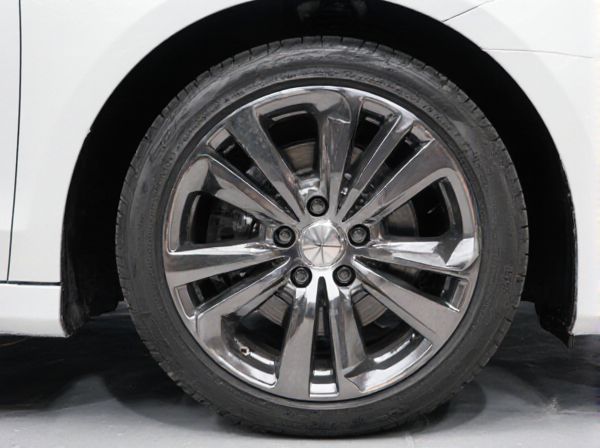
Photo illustration: Multi-piece Wheels vs Monoblock Wheels
Multi-piece wheels offer enhanced customization options and easier repair compared to monoblock wheels, which are molded from a single piece of metal providing superior strength and a lighter weight. Your choice depends on priorities such as aesthetic flexibility, budget for maintenance, and performance requirements. Multi-piece wheels allow for individual component replacement, while monoblock wheels generally deliver better rigidity and durability for high-performance applications.
Table of Comparison
| Feature | Multi-piece Wheels | Monoblock Wheels |
|---|---|---|
| Construction | Multiple components (rim + center + hardware) | Single forged or cast piece |
| Customization | Highly customizable in size, width, and finish | Limited customization options |
| Weight | Typically heavier due to multiple parts | Lighter and optimized for performance |
| Strength | Strong with added flexibility via construction | High structural integrity, very durable |
| Repairability | Individual parts can be repaired or replaced | Full wheel replacement needed if damaged |
| Cost | Generally more expensive due to complexity | More affordable and widely available |
| Typical Use | Custom builds, luxury, and performance cars | Everyday vehicles and motorsports |
Introduction to Multi-piece and Monoblock Wheels
Multi-piece wheels consist of two or three separate components--typically the rim, center, and outer lip--bolted together, offering customization in size, offset, and finish. Monoblock wheels are forged or cast from a single piece of metal, providing enhanced strength, reduced weight, and a cleaner aesthetic. Each wheel type suits different applications, with multi-piece wheels favored for adjustability and monoblock wheels prized for durability and simplicity.
Construction Differences: Multi-piece vs Monoblock Wheels
Multi-piece wheels consist of separate components--usually the rim, center, and outer lip--assembled together using bolts or welding, allowing for customization of fitment, repair, and style. Monoblock wheels are forged or cast from a single piece of aluminum or alloy, resulting in increased structural integrity, lighter weight, and enhanced strength compared to multi-piece counterparts. The construction differences directly influence performance, durability, and cost, with multi-piece wheels offering flexibility and monoblock wheels providing rigidity and simplicity.
Weight and Performance Comparison
Multi-piece wheels offer modular construction with separate rims and centers, enabling weight reduction through optimized materials and design, which enhances acceleration and handling performance. Monoblock wheels, forged from a single piece of alloy, generally weigh less than cast alternatives and provide superior rigidity, improving cornering response and overall driving dynamics. The choice between multi-piece and monoblock wheels balances weight savings against structural integrity, directly impacting vehicle performance characteristics such as agility and fuel efficiency.
Strength and Durability Factors
Multi-piece wheels offer enhanced strength due to their construction allowing for customizable components and robust assembly methods like bolting or welding, enabling better stress distribution and resistance to impact. Monoblock wheels, forged from a single piece of metal, provide superior durability by eliminating weak points such as bolts or joints, resulting in a rigid structure that withstands high loads and harsh conditions effectively. Both designs balance strength and durability differently, with multi-piece wheels excelling in modular repairs and customization, while monoblock wheels excel in structural integrity and long-term reliability.
Customization Options and Design Flexibility
Multi-piece wheels offer extensive customization options by allowing separate adjustment of the rim, center, and hardware, enabling tailored widths, offsets, and finishes to match specific vehicle aesthetics and performance needs. Monoblock wheels, cast or forged as a single piece, provide limited design flexibility but excel in structural integrity and lighter weight due to their unified construction. Enthusiasts seeking personalized style and fitment often prefer multi-piece wheels for their adaptability, while those prioritizing simplicity and strength typically choose monoblock designs.
Maintenance and Repair Considerations
Multi-piece wheels offer easier maintenance and repair due to their modular design, allowing damaged sections to be replaced individually rather than the entire wheel. Monoblock wheels, made from a single piece of material, require more extensive and costly repairs, often necessitating full replacement if damaged. The ability to disassemble multi-piece wheels simplifies cleaning, refinishing, and customization, making them more practical for ongoing upkeep.
Cost Analysis: Upfront vs Long-term Expenses
Multi-piece wheels generally have higher upfront costs due to complex manufacturing and assembly processes compared to monoblock wheels, which are cast or forged as a single unit, reducing initial expenses. Long-term expenses for multi-piece wheels often increase because of maintenance, repair, and potential replacement of individual components, whereas monoblock wheels typically offer greater durability and lower maintenance costs. Evaluating total cost of ownership reveals that monoblock wheels can provide more economical value over time, despite a higher initial price in some premium models.
Popular Applications and Vehicle Fitment
Multi-piece wheels offer customizable fitment and are popular in high-performance and luxury vehicles requiring precise offset and width adjustments, such as sports cars and custom builds. Monoblock wheels, made from a single piece of alloy, are commonly used in everyday passenger cars and SUVs due to their durability and simplified maintenance. Enthusiasts often choose multi-piece wheels for their adaptability in fitment and style, while monoblock wheels remain favored for reliable, cost-effective use on factory-spec vehicles.
Pros and Cons of Multi-piece Wheels
Multi-piece wheels offer superior customization options and ease of repair compared to monoblock wheels, allowing separate replacement of rims or centers, which enhances cost efficiency. They provide better fitment flexibility and often support wider tire options, improving vehicle performance and aesthetics. However, multi-piece wheels tend to be heavier, more expensive, and require meticulous maintenance to prevent leaks and corrosion at the joints.
Pros and Cons of Monoblock Wheels
Monoblock wheels offer superior strength and lighter weight due to their single-piece forged or cast construction, making them ideal for high-performance applications. However, they lack the customization options available with multi-piece wheels, as sizes and designs are limited by the manufacturing process. Repairing monoblock wheels can be more challenging and costly since damage often requires full replacement rather than component-level fixes.
 caratoz.com
caratoz.com